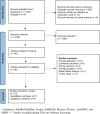Is COVID-19 severity associated with telomere length? A systematic review and meta-analysis
- PMID: 37261700
- PMCID: PMC10234232
- DOI: 10.1007/s11262-023-02010-1
Is COVID-19 severity associated with telomere length? A systematic review and meta-analysis
Abstract
Telomere shortening, a marker of cellular aging, has been linked to hospitalization and the severity of COVID-19. In this systematic review and meta-analysis, the mean difference in telomere length between non-severe and severe COVID-19 individuals was pooled to determine the association between short telomeres and COVID-19 severity. Relevant studies were retrieved through searches conducted in PubMed-Medline, Scopus, EMBASE, Medrxiv, Biorxiv, EuroPMC, and SSRN databases up to November 2022. Selected studies were systematically reviewed and assessed for risk of bias using AXIS tool. The standardized mean difference in telomere length between non-severe and severe COVID-19 was pooled using random-effects model. A total of thirteen studies were included in the review, out of which seven (1332 patients with the severe COVID-19 disease and 6321 patients with non-severe COVID-19) were eligible for meta-analysis. The estimated pooled mean difference in Leukocyte telomere length between severe COVID-19 and non-severe COVID-19 was 0.39 (95% CI - 0.02 to 0.81, I2 = 93.5%) with substantial heterogeneity. Our findings do not provide clear evidence for association of shorter telomere length and severe COVID-19 disease. More extensive studies measuring absolute telomere length with age and gender adjustments are needed to draw definitive conclusions on the potential causal association between telomere shortening and COVID-19 severity.
Keywords: Adverse outcome; Covid-19; SARS-COV-2; Severity; Telomere shortening.
© 2023. The Author(s), under exclusive licence to Springer Science+Business Media, LLC, part of Springer Nature.
Conflict of interest statement
None.
Figures
Similar articles
-
Systemic pharmacological treatments for chronic plaque psoriasis: a network meta-analysis.Cochrane Database Syst Rev. 2021 Apr 19;4(4):CD011535. doi: 10.1002/14651858.CD011535.pub4. Cochrane Database Syst Rev. 2021. Update in: Cochrane Database Syst Rev. 2022 May 23;5:CD011535. doi: 10.1002/14651858.CD011535.pub5. PMID: 33871055 Free PMC article. Updated.
-
Systemic pharmacological treatments for chronic plaque psoriasis: a network meta-analysis.Cochrane Database Syst Rev. 2017 Dec 22;12(12):CD011535. doi: 10.1002/14651858.CD011535.pub2. Cochrane Database Syst Rev. 2017. Update in: Cochrane Database Syst Rev. 2020 Jan 9;1:CD011535. doi: 10.1002/14651858.CD011535.pub3. PMID: 29271481 Free PMC article. Updated.
-
Signs and symptoms to determine if a patient presenting in primary care or hospital outpatient settings has COVID-19.Cochrane Database Syst Rev. 2022 May 20;5(5):CD013665. doi: 10.1002/14651858.CD013665.pub3. Cochrane Database Syst Rev. 2022. PMID: 35593186 Free PMC article.
-
The association between post-traumatic stress disorder and shorter telomere length: A systematic review and meta-analysis.J Affect Disord. 2017 Aug 15;218:322-326. doi: 10.1016/j.jad.2017.03.048. Epub 2017 Mar 27. J Affect Disord. 2017. PMID: 28486180
-
Rapid, point-of-care antigen tests for diagnosis of SARS-CoV-2 infection.Cochrane Database Syst Rev. 2022 Jul 22;7(7):CD013705. doi: 10.1002/14651858.CD013705.pub3. Cochrane Database Syst Rev. 2022. PMID: 35866452 Free PMC article.
Cited by
-
SARS-CoV-2 and the DNA damage response.J Gen Virol. 2023 Nov;104(11):001918. doi: 10.1099/jgv.0.001918. J Gen Virol. 2023. PMID: 37948194 Free PMC article. Review.
-
Exploring the Relationship between Telomere Length and Cognitive Changes in Post-COVID-19 Subjects.Biomedicines. 2024 Oct 10;12(10):2296. doi: 10.3390/biomedicines12102296. Biomedicines. 2024. PMID: 39457609 Free PMC article.
-
Telomere length and COVID-19 disease severity: insights from hospitalized patients.Front Aging. 2025 Jun 10;6:1577788. doi: 10.3389/fragi.2025.1577788. eCollection 2025. Front Aging. 2025. PMID: 40556866 Free PMC article.
-
Effect of SARS-CoV-2 infection on sperm telomere length.J Assist Reprod Genet. 2025 Apr;42(4):1167-1175. doi: 10.1007/s10815-025-03408-6. Epub 2025 Feb 11. J Assist Reprod Genet. 2025. PMID: 39934464
-
Longer ICU stay and invasive mechanical ventilation accelerate telomere shortening in COVID-19 patients 1 year after recovery.Crit Care. 2024 Aug 7;28(1):267. doi: 10.1186/s13054-024-05051-6. Crit Care. 2024. PMID: 39113075 Free PMC article.
References
Publication types
MeSH terms
LinkOut - more resources
Full Text Sources
Medical
Miscellaneous



